Consumer Needs and Marketing Strategies: Unilever & IKEA
VerifiedAdded on 2021/05/31
|11
|3381
|79
Report
AI Summary
This report examines the marketing strategies of Unilever and IKEA, delving into their understanding of consumer needs and their application of internal and external consumer processes. It analyzes Unilever's use of social media, particularly the Dove Campaign for Real Beauty, and assesses the importance of external processes like ethnicity. The report also explores Unilever's efforts to promote healthy and sustainable behaviors. Furthermore, it evaluates IKEA's Manland experiment, its advantages, disadvantages, and potential for expansion. The report classifies IKEA's products in terms of consumer behavior (conspicuous consumption, voluntary simplicity, and compensatory consumption) and discusses the impact of controversial advertising campaigns on IKEA's image.
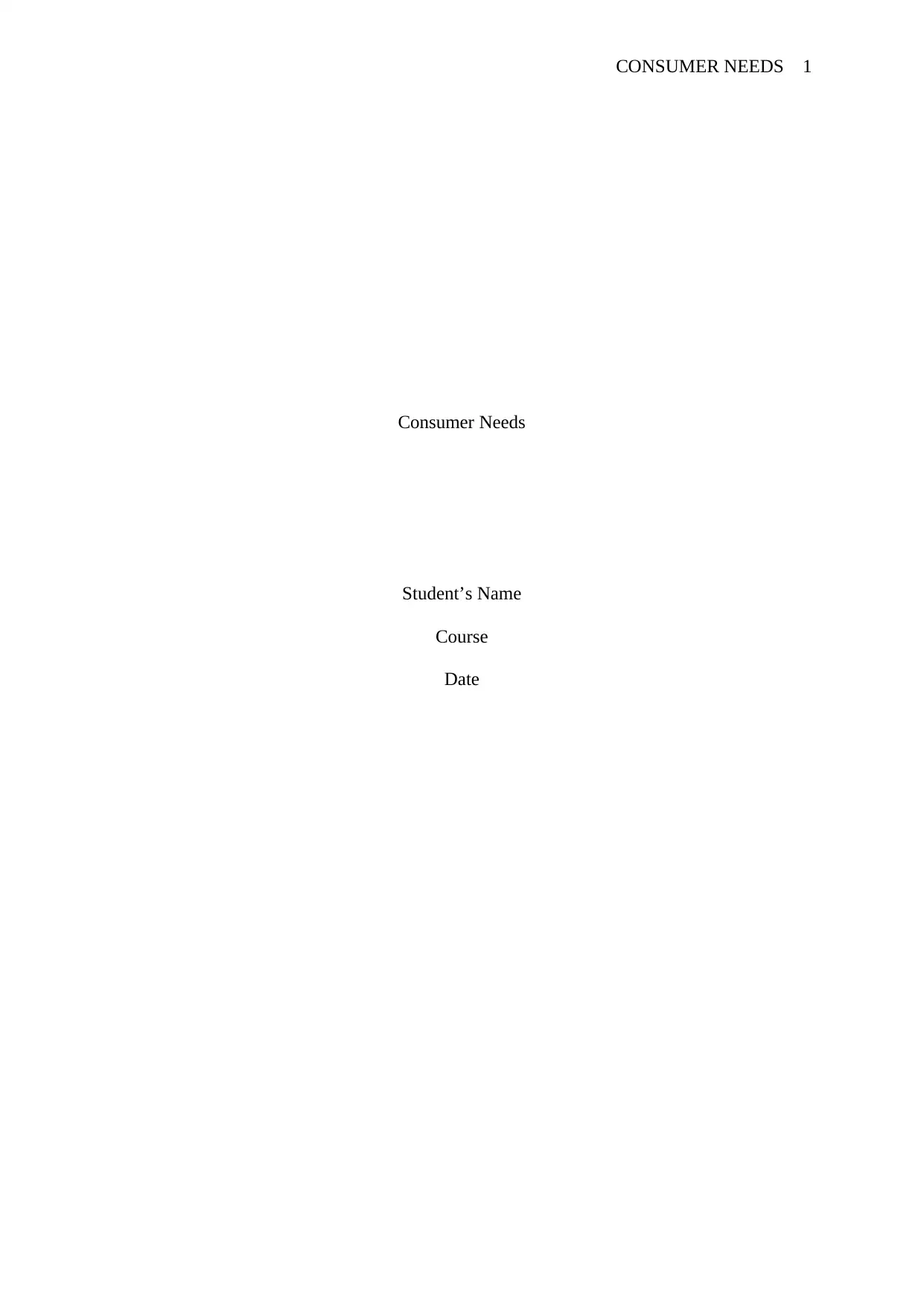
CONSUMER NEEDS 1
Consumer Needs
Student’s Name
Course
Date
Consumer Needs
Student’s Name
Course
Date
Paraphrase This Document
Need a fresh take? Get an instant paraphrase of this document with our AI Paraphraser
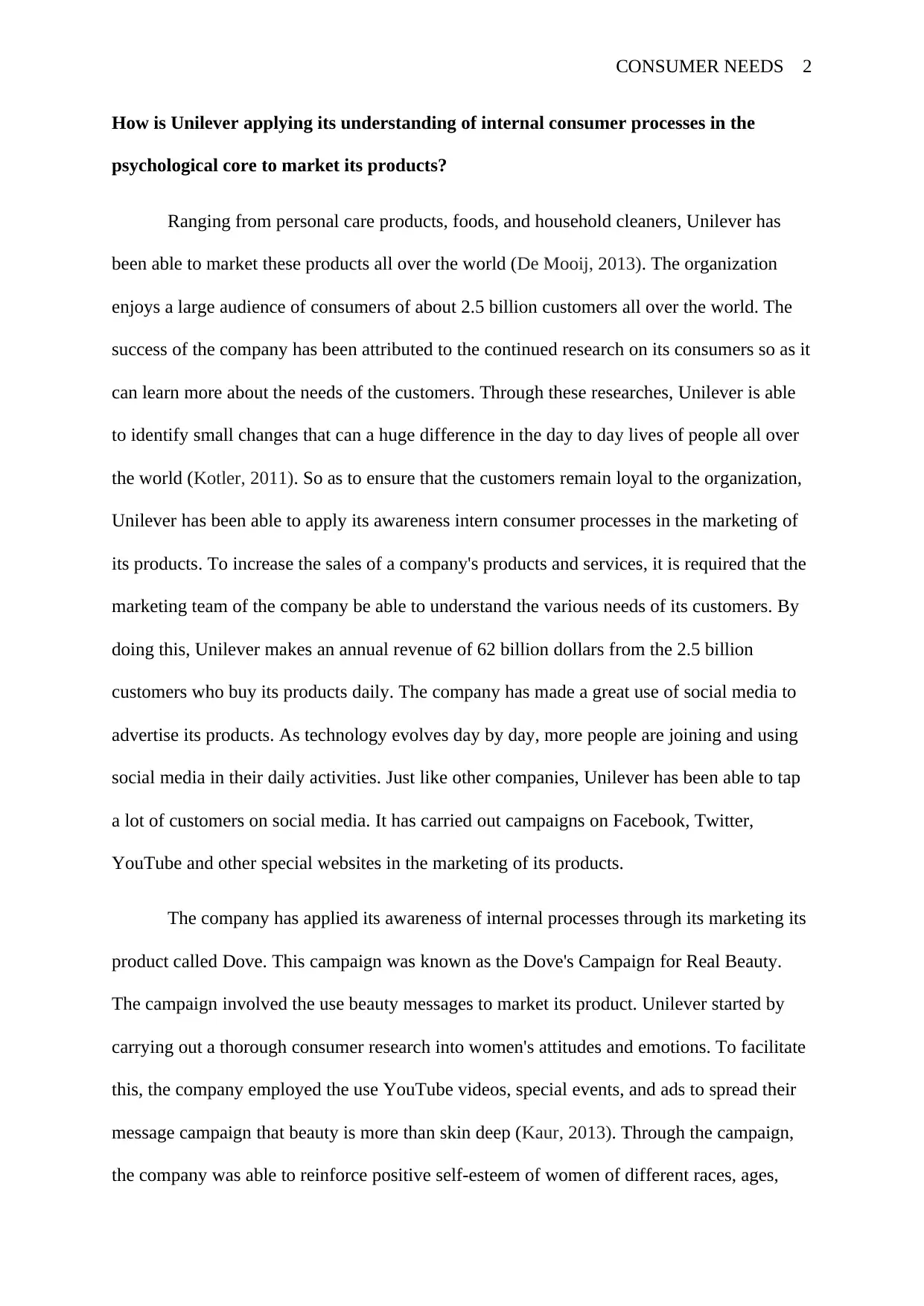
CONSUMER NEEDS 2
How is Unilever applying its understanding of internal consumer processes in the
psychological core to market its products?
Ranging from personal care products, foods, and household cleaners, Unilever has
been able to market these products all over the world (De Mooij, 2013). The organization
enjoys a large audience of consumers of about 2.5 billion customers all over the world. The
success of the company has been attributed to the continued research on its consumers so as it
can learn more about the needs of the customers. Through these researches, Unilever is able
to identify small changes that can a huge difference in the day to day lives of people all over
the world (Kotler, 2011). So as to ensure that the customers remain loyal to the organization,
Unilever has been able to apply its awareness intern consumer processes in the marketing of
its products. To increase the sales of a company's products and services, it is required that the
marketing team of the company be able to understand the various needs of its customers. By
doing this, Unilever makes an annual revenue of 62 billion dollars from the 2.5 billion
customers who buy its products daily. The company has made a great use of social media to
advertise its products. As technology evolves day by day, more people are joining and using
social media in their daily activities. Just like other companies, Unilever has been able to tap
a lot of customers on social media. It has carried out campaigns on Facebook, Twitter,
YouTube and other special websites in the marketing of its products.
The company has applied its awareness of internal processes through its marketing its
product called Dove. This campaign was known as the Dove's Campaign for Real Beauty.
The campaign involved the use beauty messages to market its product. Unilever started by
carrying out a thorough consumer research into women's attitudes and emotions. To facilitate
this, the company employed the use YouTube videos, special events, and ads to spread their
message campaign that beauty is more than skin deep (Kaur, 2013). Through the campaign,
the company was able to reinforce positive self-esteem of women of different races, ages,
How is Unilever applying its understanding of internal consumer processes in the
psychological core to market its products?
Ranging from personal care products, foods, and household cleaners, Unilever has
been able to market these products all over the world (De Mooij, 2013). The organization
enjoys a large audience of consumers of about 2.5 billion customers all over the world. The
success of the company has been attributed to the continued research on its consumers so as it
can learn more about the needs of the customers. Through these researches, Unilever is able
to identify small changes that can a huge difference in the day to day lives of people all over
the world (Kotler, 2011). So as to ensure that the customers remain loyal to the organization,
Unilever has been able to apply its awareness intern consumer processes in the marketing of
its products. To increase the sales of a company's products and services, it is required that the
marketing team of the company be able to understand the various needs of its customers. By
doing this, Unilever makes an annual revenue of 62 billion dollars from the 2.5 billion
customers who buy its products daily. The company has made a great use of social media to
advertise its products. As technology evolves day by day, more people are joining and using
social media in their daily activities. Just like other companies, Unilever has been able to tap
a lot of customers on social media. It has carried out campaigns on Facebook, Twitter,
YouTube and other special websites in the marketing of its products.
The company has applied its awareness of internal processes through its marketing its
product called Dove. This campaign was known as the Dove's Campaign for Real Beauty.
The campaign involved the use beauty messages to market its product. Unilever started by
carrying out a thorough consumer research into women's attitudes and emotions. To facilitate
this, the company employed the use YouTube videos, special events, and ads to spread their
message campaign that beauty is more than skin deep (Kaur, 2013). Through the campaign,
the company was able to reinforce positive self-esteem of women of different races, ages,
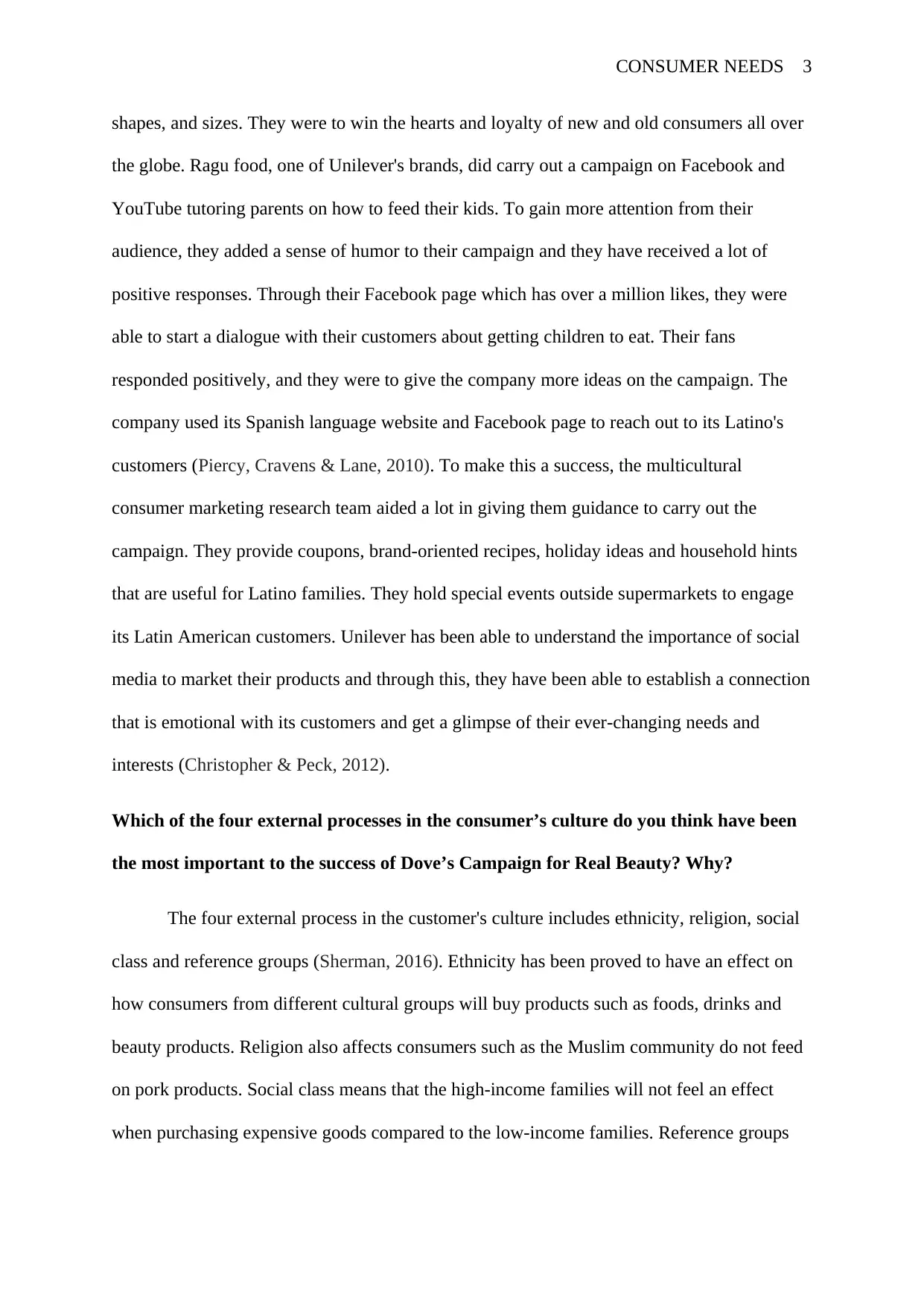
CONSUMER NEEDS 3
shapes, and sizes. They were to win the hearts and loyalty of new and old consumers all over
the globe. Ragu food, one of Unilever's brands, did carry out a campaign on Facebook and
YouTube tutoring parents on how to feed their kids. To gain more attention from their
audience, they added a sense of humor to their campaign and they have received a lot of
positive responses. Through their Facebook page which has over a million likes, they were
able to start a dialogue with their customers about getting children to eat. Their fans
responded positively, and they were to give the company more ideas on the campaign. The
company used its Spanish language website and Facebook page to reach out to its Latino's
customers (Piercy, Cravens & Lane, 2010). To make this a success, the multicultural
consumer marketing research team aided a lot in giving them guidance to carry out the
campaign. They provide coupons, brand-oriented recipes, holiday ideas and household hints
that are useful for Latino families. They hold special events outside supermarkets to engage
its Latin American customers. Unilever has been able to understand the importance of social
media to market their products and through this, they have been able to establish a connection
that is emotional with its customers and get a glimpse of their ever-changing needs and
interests (Christopher & Peck, 2012).
Which of the four external processes in the consumer’s culture do you think have been
the most important to the success of Dove’s Campaign for Real Beauty? Why?
The four external process in the customer's culture includes ethnicity, religion, social
class and reference groups (Sherman, 2016). Ethnicity has been proved to have an effect on
how consumers from different cultural groups will buy products such as foods, drinks and
beauty products. Religion also affects consumers such as the Muslim community do not feed
on pork products. Social class means that the high-income families will not feel an effect
when purchasing expensive goods compared to the low-income families. Reference groups
shapes, and sizes. They were to win the hearts and loyalty of new and old consumers all over
the globe. Ragu food, one of Unilever's brands, did carry out a campaign on Facebook and
YouTube tutoring parents on how to feed their kids. To gain more attention from their
audience, they added a sense of humor to their campaign and they have received a lot of
positive responses. Through their Facebook page which has over a million likes, they were
able to start a dialogue with their customers about getting children to eat. Their fans
responded positively, and they were to give the company more ideas on the campaign. The
company used its Spanish language website and Facebook page to reach out to its Latino's
customers (Piercy, Cravens & Lane, 2010). To make this a success, the multicultural
consumer marketing research team aided a lot in giving them guidance to carry out the
campaign. They provide coupons, brand-oriented recipes, holiday ideas and household hints
that are useful for Latino families. They hold special events outside supermarkets to engage
its Latin American customers. Unilever has been able to understand the importance of social
media to market their products and through this, they have been able to establish a connection
that is emotional with its customers and get a glimpse of their ever-changing needs and
interests (Christopher & Peck, 2012).
Which of the four external processes in the consumer’s culture do you think have been
the most important to the success of Dove’s Campaign for Real Beauty? Why?
The four external process in the customer's culture includes ethnicity, religion, social
class and reference groups (Sherman, 2016). Ethnicity has been proved to have an effect on
how consumers from different cultural groups will buy products such as foods, drinks and
beauty products. Religion also affects consumers such as the Muslim community do not feed
on pork products. Social class means that the high-income families will not feel an effect
when purchasing expensive goods compared to the low-income families. Reference groups
⊘ This is a preview!⊘
Do you want full access?
Subscribe today to unlock all pages.

Trusted by 1+ million students worldwide
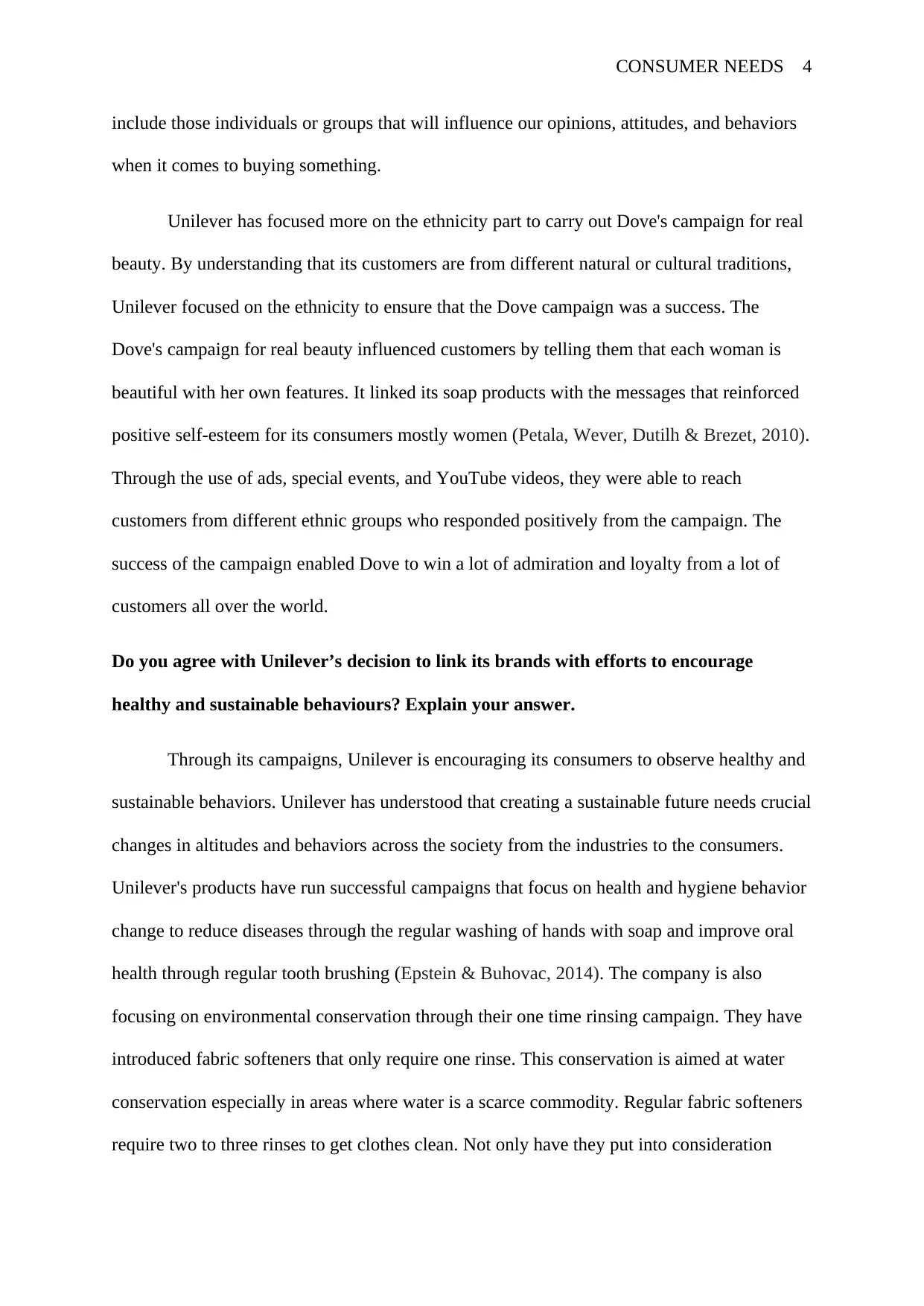
CONSUMER NEEDS 4
include those individuals or groups that will influence our opinions, attitudes, and behaviors
when it comes to buying something.
Unilever has focused more on the ethnicity part to carry out Dove's campaign for real
beauty. By understanding that its customers are from different natural or cultural traditions,
Unilever focused on the ethnicity to ensure that the Dove campaign was a success. The
Dove's campaign for real beauty influenced customers by telling them that each woman is
beautiful with her own features. It linked its soap products with the messages that reinforced
positive self-esteem for its consumers mostly women (Petala, Wever, Dutilh & Brezet, 2010).
Through the use of ads, special events, and YouTube videos, they were able to reach
customers from different ethnic groups who responded positively from the campaign. The
success of the campaign enabled Dove to win a lot of admiration and loyalty from a lot of
customers all over the world.
Do you agree with Unilever’s decision to link its brands with efforts to encourage
healthy and sustainable behaviours? Explain your answer.
Through its campaigns, Unilever is encouraging its consumers to observe healthy and
sustainable behaviors. Unilever has understood that creating a sustainable future needs crucial
changes in altitudes and behaviors across the society from the industries to the consumers.
Unilever's products have run successful campaigns that focus on health and hygiene behavior
change to reduce diseases through the regular washing of hands with soap and improve oral
health through regular tooth brushing (Epstein & Buhovac, 2014). The company is also
focusing on environmental conservation through their one time rinsing campaign. They have
introduced fabric softeners that only require one rinse. This conservation is aimed at water
conservation especially in areas where water is a scarce commodity. Regular fabric softeners
require two to three rinses to get clothes clean. Not only have they put into consideration
include those individuals or groups that will influence our opinions, attitudes, and behaviors
when it comes to buying something.
Unilever has focused more on the ethnicity part to carry out Dove's campaign for real
beauty. By understanding that its customers are from different natural or cultural traditions,
Unilever focused on the ethnicity to ensure that the Dove campaign was a success. The
Dove's campaign for real beauty influenced customers by telling them that each woman is
beautiful with her own features. It linked its soap products with the messages that reinforced
positive self-esteem for its consumers mostly women (Petala, Wever, Dutilh & Brezet, 2010).
Through the use of ads, special events, and YouTube videos, they were able to reach
customers from different ethnic groups who responded positively from the campaign. The
success of the campaign enabled Dove to win a lot of admiration and loyalty from a lot of
customers all over the world.
Do you agree with Unilever’s decision to link its brands with efforts to encourage
healthy and sustainable behaviours? Explain your answer.
Through its campaigns, Unilever is encouraging its consumers to observe healthy and
sustainable behaviors. Unilever has understood that creating a sustainable future needs crucial
changes in altitudes and behaviors across the society from the industries to the consumers.
Unilever's products have run successful campaigns that focus on health and hygiene behavior
change to reduce diseases through the regular washing of hands with soap and improve oral
health through regular tooth brushing (Epstein & Buhovac, 2014). The company is also
focusing on environmental conservation through their one time rinsing campaign. They have
introduced fabric softeners that only require one rinse. This conservation is aimed at water
conservation especially in areas where water is a scarce commodity. Regular fabric softeners
require two to three rinses to get clothes clean. Not only have they put into consideration
Paraphrase This Document
Need a fresh take? Get an instant paraphrase of this document with our AI Paraphraser
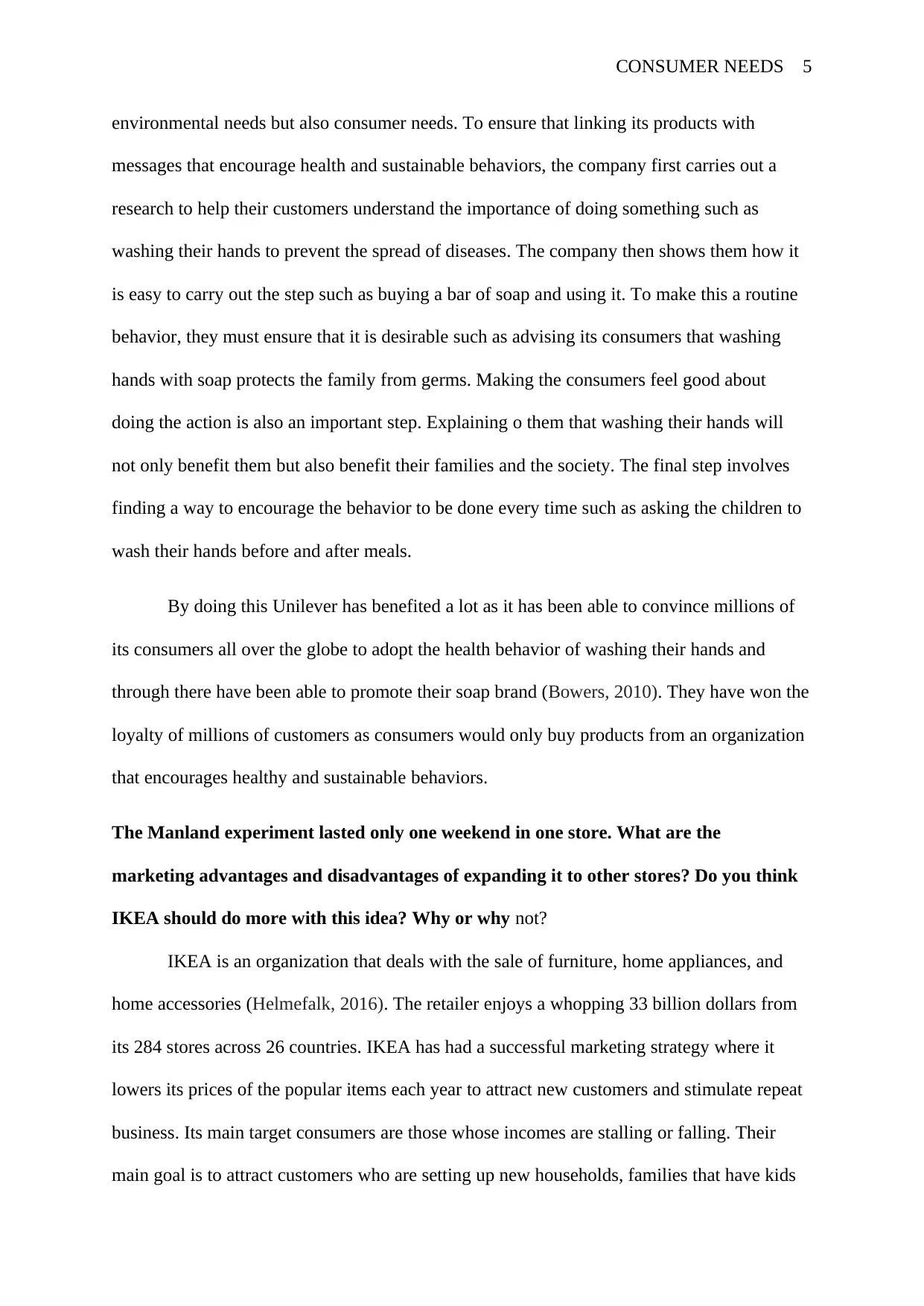
CONSUMER NEEDS 5
environmental needs but also consumer needs. To ensure that linking its products with
messages that encourage health and sustainable behaviors, the company first carries out a
research to help their customers understand the importance of doing something such as
washing their hands to prevent the spread of diseases. The company then shows them how it
is easy to carry out the step such as buying a bar of soap and using it. To make this a routine
behavior, they must ensure that it is desirable such as advising its consumers that washing
hands with soap protects the family from germs. Making the consumers feel good about
doing the action is also an important step. Explaining o them that washing their hands will
not only benefit them but also benefit their families and the society. The final step involves
finding a way to encourage the behavior to be done every time such as asking the children to
wash their hands before and after meals.
By doing this Unilever has benefited a lot as it has been able to convince millions of
its consumers all over the globe to adopt the health behavior of washing their hands and
through there have been able to promote their soap brand (Bowers, 2010). They have won the
loyalty of millions of customers as consumers would only buy products from an organization
that encourages healthy and sustainable behaviors.
The Manland experiment lasted only one weekend in one store. What are the
marketing advantages and disadvantages of expanding it to other stores? Do you think
IKEA should do more with this idea? Why or why not?
IKEA is an organization that deals with the sale of furniture, home appliances, and
home accessories (Helmefalk, 2016). The retailer enjoys a whopping 33 billion dollars from
its 284 stores across 26 countries. IKEA has had a successful marketing strategy where it
lowers its prices of the popular items each year to attract new customers and stimulate repeat
business. Its main target consumers are those whose incomes are stalling or falling. Their
main goal is to attract customers who are setting up new households, families that have kids
environmental needs but also consumer needs. To ensure that linking its products with
messages that encourage health and sustainable behaviors, the company first carries out a
research to help their customers understand the importance of doing something such as
washing their hands to prevent the spread of diseases. The company then shows them how it
is easy to carry out the step such as buying a bar of soap and using it. To make this a routine
behavior, they must ensure that it is desirable such as advising its consumers that washing
hands with soap protects the family from germs. Making the consumers feel good about
doing the action is also an important step. Explaining o them that washing their hands will
not only benefit them but also benefit their families and the society. The final step involves
finding a way to encourage the behavior to be done every time such as asking the children to
wash their hands before and after meals.
By doing this Unilever has benefited a lot as it has been able to convince millions of
its consumers all over the globe to adopt the health behavior of washing their hands and
through there have been able to promote their soap brand (Bowers, 2010). They have won the
loyalty of millions of customers as consumers would only buy products from an organization
that encourages healthy and sustainable behaviors.
The Manland experiment lasted only one weekend in one store. What are the
marketing advantages and disadvantages of expanding it to other stores? Do you think
IKEA should do more with this idea? Why or why not?
IKEA is an organization that deals with the sale of furniture, home appliances, and
home accessories (Helmefalk, 2016). The retailer enjoys a whopping 33 billion dollars from
its 284 stores across 26 countries. IKEA has had a successful marketing strategy where it
lowers its prices of the popular items each year to attract new customers and stimulate repeat
business. Its main target consumers are those whose incomes are stalling or falling. Their
main goal is to attract customers who are setting up new households, families that have kids
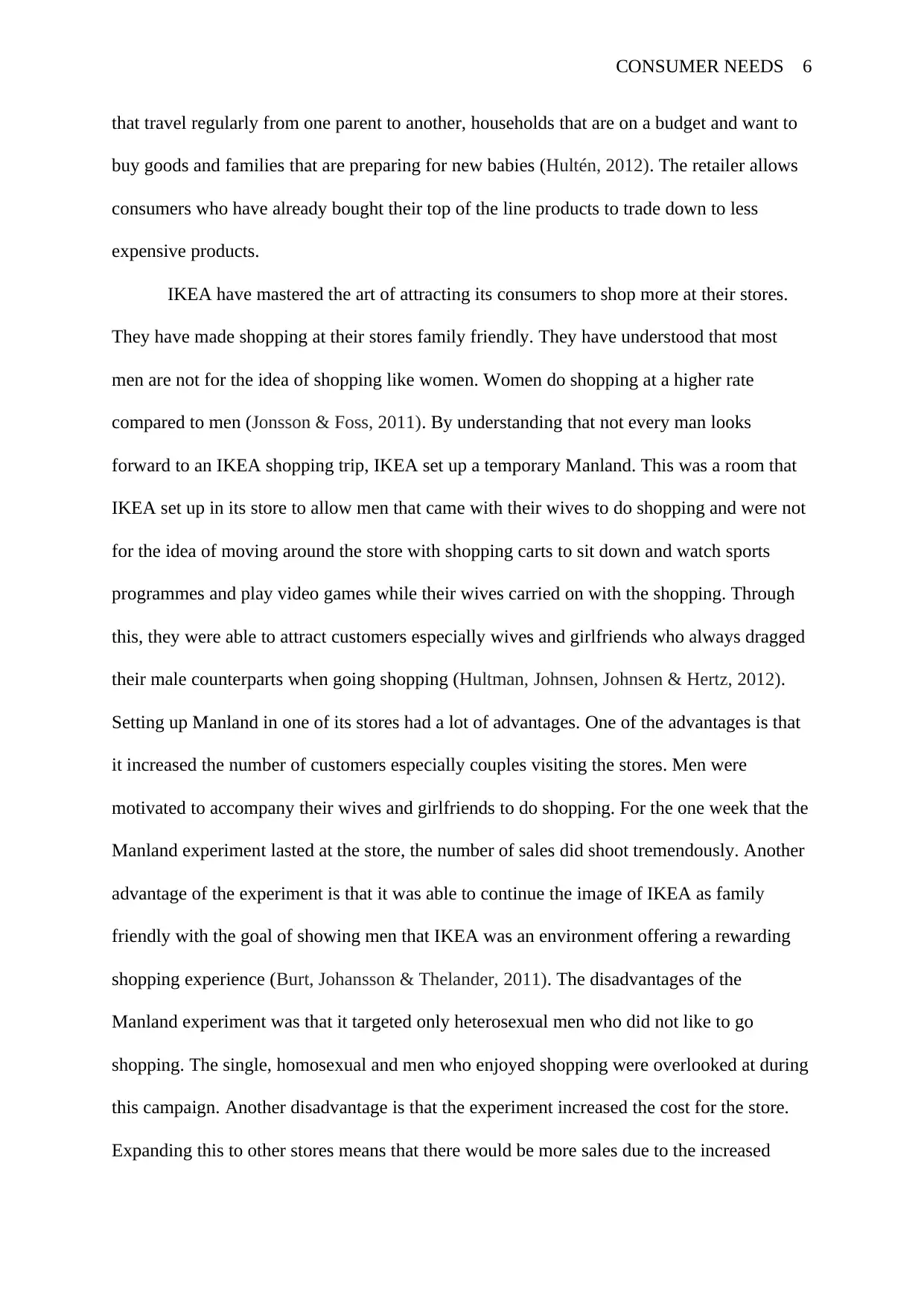
CONSUMER NEEDS 6
that travel regularly from one parent to another, households that are on a budget and want to
buy goods and families that are preparing for new babies (Hultén, 2012). The retailer allows
consumers who have already bought their top of the line products to trade down to less
expensive products.
IKEA have mastered the art of attracting its consumers to shop more at their stores.
They have made shopping at their stores family friendly. They have understood that most
men are not for the idea of shopping like women. Women do shopping at a higher rate
compared to men (Jonsson & Foss, 2011). By understanding that not every man looks
forward to an IKEA shopping trip, IKEA set up a temporary Manland. This was a room that
IKEA set up in its store to allow men that came with their wives to do shopping and were not
for the idea of moving around the store with shopping carts to sit down and watch sports
programmes and play video games while their wives carried on with the shopping. Through
this, they were able to attract customers especially wives and girlfriends who always dragged
their male counterparts when going shopping (Hultman, Johnsen, Johnsen & Hertz, 2012).
Setting up Manland in one of its stores had a lot of advantages. One of the advantages is that
it increased the number of customers especially couples visiting the stores. Men were
motivated to accompany their wives and girlfriends to do shopping. For the one week that the
Manland experiment lasted at the store, the number of sales did shoot tremendously. Another
advantage of the experiment is that it was able to continue the image of IKEA as family
friendly with the goal of showing men that IKEA was an environment offering a rewarding
shopping experience (Burt, Johansson & Thelander, 2011). The disadvantages of the
Manland experiment was that it targeted only heterosexual men who did not like to go
shopping. The single, homosexual and men who enjoyed shopping were overlooked at during
this campaign. Another disadvantage is that the experiment increased the cost for the store.
Expanding this to other stores means that there would be more sales due to the increased
that travel regularly from one parent to another, households that are on a budget and want to
buy goods and families that are preparing for new babies (Hultén, 2012). The retailer allows
consumers who have already bought their top of the line products to trade down to less
expensive products.
IKEA have mastered the art of attracting its consumers to shop more at their stores.
They have made shopping at their stores family friendly. They have understood that most
men are not for the idea of shopping like women. Women do shopping at a higher rate
compared to men (Jonsson & Foss, 2011). By understanding that not every man looks
forward to an IKEA shopping trip, IKEA set up a temporary Manland. This was a room that
IKEA set up in its store to allow men that came with their wives to do shopping and were not
for the idea of moving around the store with shopping carts to sit down and watch sports
programmes and play video games while their wives carried on with the shopping. Through
this, they were able to attract customers especially wives and girlfriends who always dragged
their male counterparts when going shopping (Hultman, Johnsen, Johnsen & Hertz, 2012).
Setting up Manland in one of its stores had a lot of advantages. One of the advantages is that
it increased the number of customers especially couples visiting the stores. Men were
motivated to accompany their wives and girlfriends to do shopping. For the one week that the
Manland experiment lasted at the store, the number of sales did shoot tremendously. Another
advantage of the experiment is that it was able to continue the image of IKEA as family
friendly with the goal of showing men that IKEA was an environment offering a rewarding
shopping experience (Burt, Johansson & Thelander, 2011). The disadvantages of the
Manland experiment was that it targeted only heterosexual men who did not like to go
shopping. The single, homosexual and men who enjoyed shopping were overlooked at during
this campaign. Another disadvantage is that the experiment increased the cost for the store.
Expanding this to other stores means that there would be more sales due to the increased
⊘ This is a preview!⊘
Do you want full access?
Subscribe today to unlock all pages.

Trusted by 1+ million students worldwide
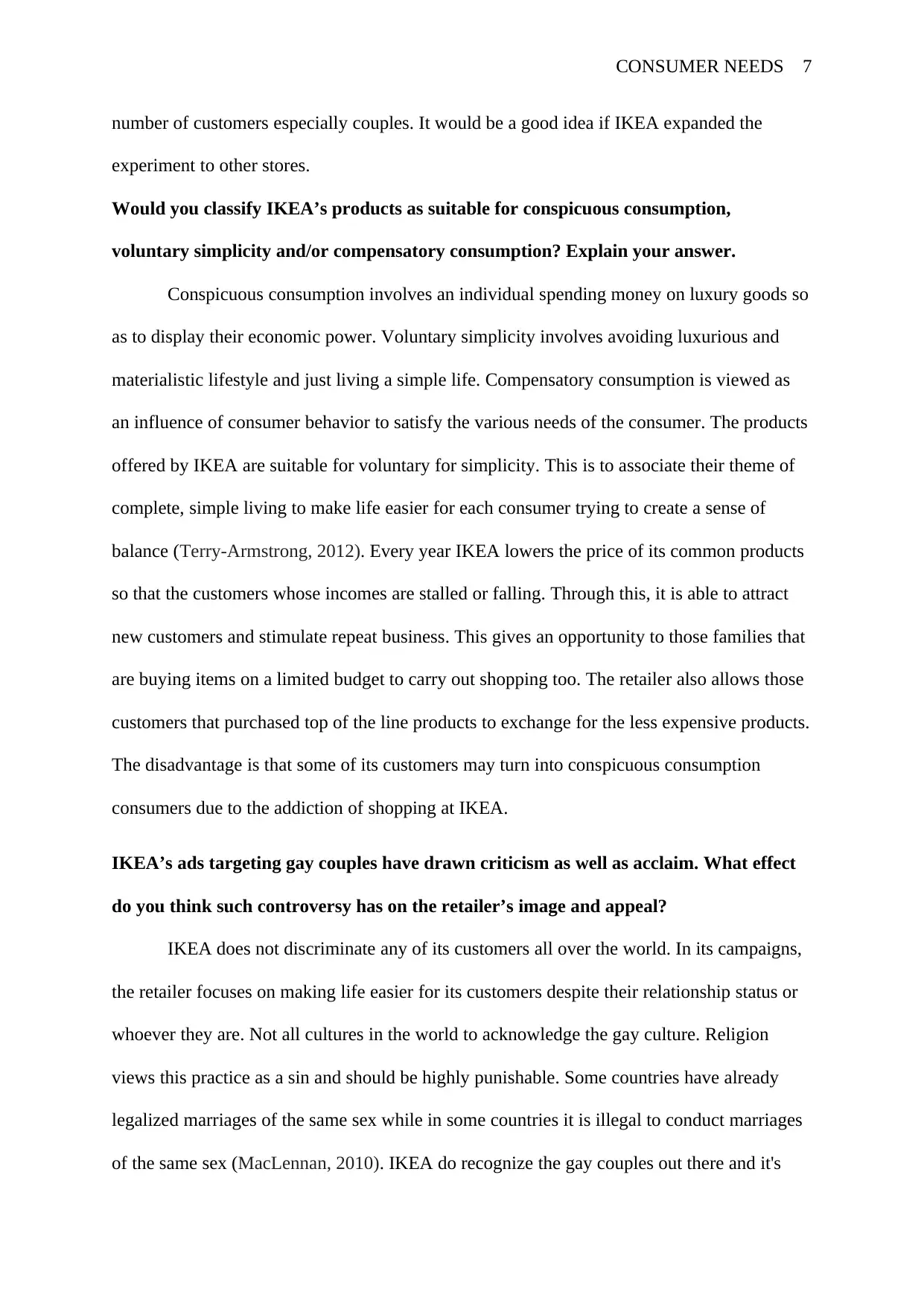
CONSUMER NEEDS 7
number of customers especially couples. It would be a good idea if IKEA expanded the
experiment to other stores.
Would you classify IKEA’s products as suitable for conspicuous consumption,
voluntary simplicity and/or compensatory consumption? Explain your answer.
Conspicuous consumption involves an individual spending money on luxury goods so
as to display their economic power. Voluntary simplicity involves avoiding luxurious and
materialistic lifestyle and just living a simple life. Compensatory consumption is viewed as
an influence of consumer behavior to satisfy the various needs of the consumer. The products
offered by IKEA are suitable for voluntary for simplicity. This is to associate their theme of
complete, simple living to make life easier for each consumer trying to create a sense of
balance (Terry-Armstrong, 2012). Every year IKEA lowers the price of its common products
so that the customers whose incomes are stalled or falling. Through this, it is able to attract
new customers and stimulate repeat business. This gives an opportunity to those families that
are buying items on a limited budget to carry out shopping too. The retailer also allows those
customers that purchased top of the line products to exchange for the less expensive products.
The disadvantage is that some of its customers may turn into conspicuous consumption
consumers due to the addiction of shopping at IKEA.
IKEA’s ads targeting gay couples have drawn criticism as well as acclaim. What effect
do you think such controversy has on the retailer’s image and appeal?
IKEA does not discriminate any of its customers all over the world. In its campaigns,
the retailer focuses on making life easier for its customers despite their relationship status or
whoever they are. Not all cultures in the world to acknowledge the gay culture. Religion
views this practice as a sin and should be highly punishable. Some countries have already
legalized marriages of the same sex while in some countries it is illegal to conduct marriages
of the same sex (MacLennan, 2010). IKEA do recognize the gay couples out there and it's
number of customers especially couples. It would be a good idea if IKEA expanded the
experiment to other stores.
Would you classify IKEA’s products as suitable for conspicuous consumption,
voluntary simplicity and/or compensatory consumption? Explain your answer.
Conspicuous consumption involves an individual spending money on luxury goods so
as to display their economic power. Voluntary simplicity involves avoiding luxurious and
materialistic lifestyle and just living a simple life. Compensatory consumption is viewed as
an influence of consumer behavior to satisfy the various needs of the consumer. The products
offered by IKEA are suitable for voluntary for simplicity. This is to associate their theme of
complete, simple living to make life easier for each consumer trying to create a sense of
balance (Terry-Armstrong, 2012). Every year IKEA lowers the price of its common products
so that the customers whose incomes are stalled or falling. Through this, it is able to attract
new customers and stimulate repeat business. This gives an opportunity to those families that
are buying items on a limited budget to carry out shopping too. The retailer also allows those
customers that purchased top of the line products to exchange for the less expensive products.
The disadvantage is that some of its customers may turn into conspicuous consumption
consumers due to the addiction of shopping at IKEA.
IKEA’s ads targeting gay couples have drawn criticism as well as acclaim. What effect
do you think such controversy has on the retailer’s image and appeal?
IKEA does not discriminate any of its customers all over the world. In its campaigns,
the retailer focuses on making life easier for its customers despite their relationship status or
whoever they are. Not all cultures in the world to acknowledge the gay culture. Religion
views this practice as a sin and should be highly punishable. Some countries have already
legalized marriages of the same sex while in some countries it is illegal to conduct marriages
of the same sex (MacLennan, 2010). IKEA do recognize the gay couples out there and it's
Paraphrase This Document
Need a fresh take? Get an instant paraphrase of this document with our AI Paraphraser
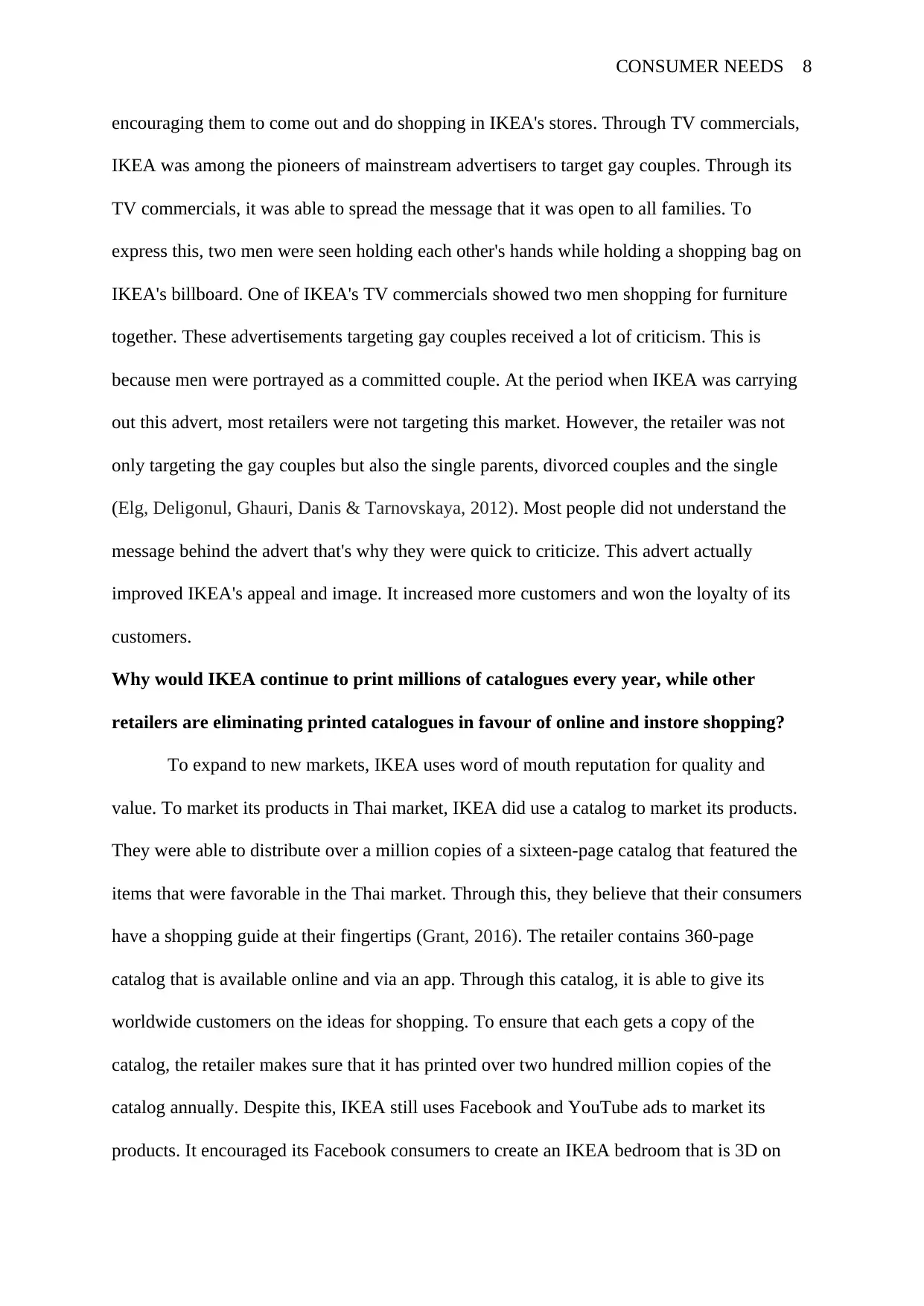
CONSUMER NEEDS 8
encouraging them to come out and do shopping in IKEA's stores. Through TV commercials,
IKEA was among the pioneers of mainstream advertisers to target gay couples. Through its
TV commercials, it was able to spread the message that it was open to all families. To
express this, two men were seen holding each other's hands while holding a shopping bag on
IKEA's billboard. One of IKEA's TV commercials showed two men shopping for furniture
together. These advertisements targeting gay couples received a lot of criticism. This is
because men were portrayed as a committed couple. At the period when IKEA was carrying
out this advert, most retailers were not targeting this market. However, the retailer was not
only targeting the gay couples but also the single parents, divorced couples and the single
(Elg, Deligonul, Ghauri, Danis & Tarnovskaya, 2012). Most people did not understand the
message behind the advert that's why they were quick to criticize. This advert actually
improved IKEA's appeal and image. It increased more customers and won the loyalty of its
customers.
Why would IKEA continue to print millions of catalogues every year, while other
retailers are eliminating printed catalogues in favour of online and instore shopping?
To expand to new markets, IKEA uses word of mouth reputation for quality and
value. To market its products in Thai market, IKEA did use a catalog to market its products.
They were able to distribute over a million copies of a sixteen-page catalog that featured the
items that were favorable in the Thai market. Through this, they believe that their consumers
have a shopping guide at their fingertips (Grant, 2016). The retailer contains 360-page
catalog that is available online and via an app. Through this catalog, it is able to give its
worldwide customers on the ideas for shopping. To ensure that each gets a copy of the
catalog, the retailer makes sure that it has printed over two hundred million copies of the
catalog annually. Despite this, IKEA still uses Facebook and YouTube ads to market its
products. It encouraged its Facebook consumers to create an IKEA bedroom that is 3D on
encouraging them to come out and do shopping in IKEA's stores. Through TV commercials,
IKEA was among the pioneers of mainstream advertisers to target gay couples. Through its
TV commercials, it was able to spread the message that it was open to all families. To
express this, two men were seen holding each other's hands while holding a shopping bag on
IKEA's billboard. One of IKEA's TV commercials showed two men shopping for furniture
together. These advertisements targeting gay couples received a lot of criticism. This is
because men were portrayed as a committed couple. At the period when IKEA was carrying
out this advert, most retailers were not targeting this market. However, the retailer was not
only targeting the gay couples but also the single parents, divorced couples and the single
(Elg, Deligonul, Ghauri, Danis & Tarnovskaya, 2012). Most people did not understand the
message behind the advert that's why they were quick to criticize. This advert actually
improved IKEA's appeal and image. It increased more customers and won the loyalty of its
customers.
Why would IKEA continue to print millions of catalogues every year, while other
retailers are eliminating printed catalogues in favour of online and instore shopping?
To expand to new markets, IKEA uses word of mouth reputation for quality and
value. To market its products in Thai market, IKEA did use a catalog to market its products.
They were able to distribute over a million copies of a sixteen-page catalog that featured the
items that were favorable in the Thai market. Through this, they believe that their consumers
have a shopping guide at their fingertips (Grant, 2016). The retailer contains 360-page
catalog that is available online and via an app. Through this catalog, it is able to give its
worldwide customers on the ideas for shopping. To ensure that each gets a copy of the
catalog, the retailer makes sure that it has printed over two hundred million copies of the
catalog annually. Despite this, IKEA still uses Facebook and YouTube ads to market its
products. It encouraged its Facebook consumers to create an IKEA bedroom that is 3D on
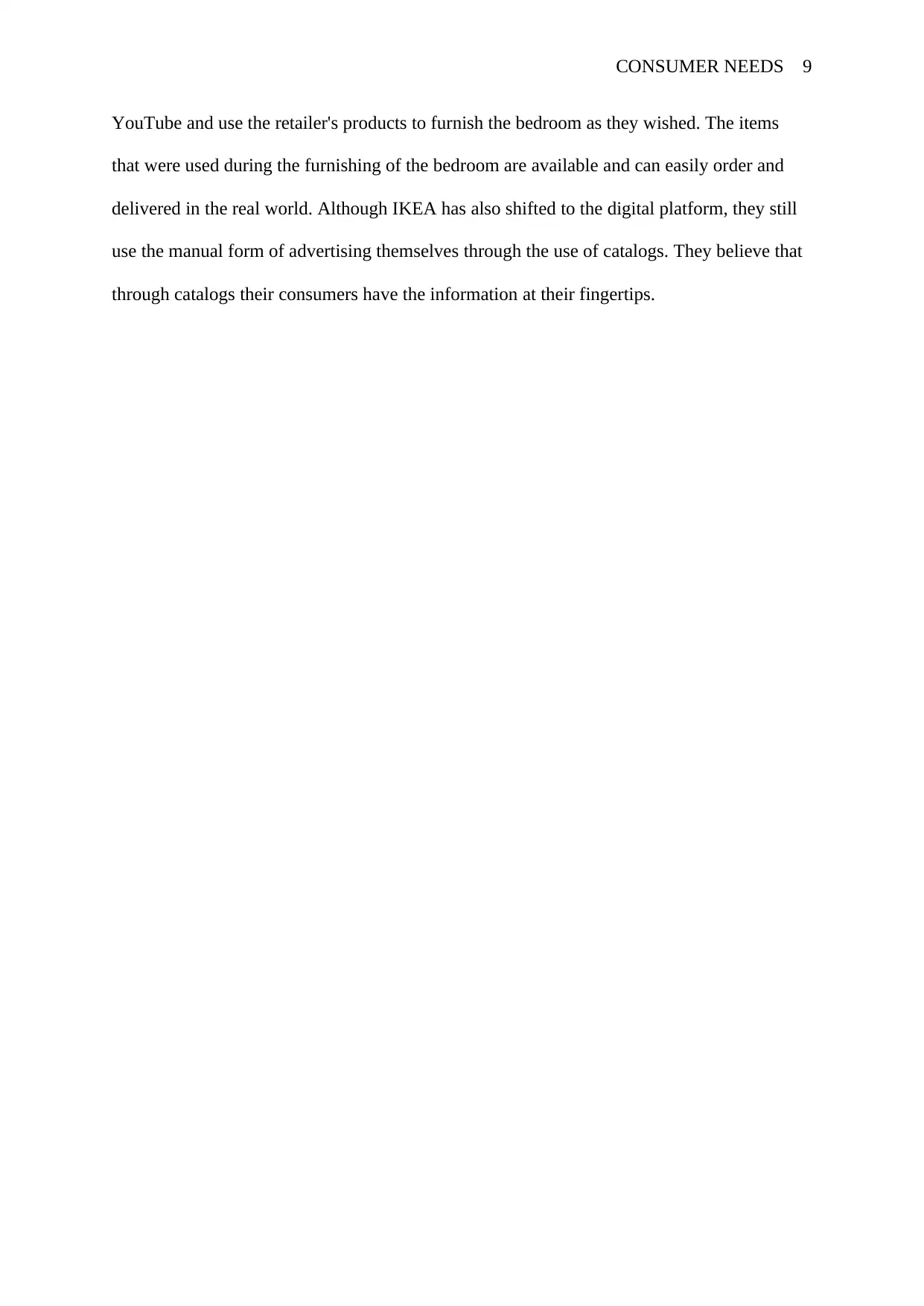
CONSUMER NEEDS 9
YouTube and use the retailer's products to furnish the bedroom as they wished. The items
that were used during the furnishing of the bedroom are available and can easily order and
delivered in the real world. Although IKEA has also shifted to the digital platform, they still
use the manual form of advertising themselves through the use of catalogs. They believe that
through catalogs their consumers have the information at their fingertips.
YouTube and use the retailer's products to furnish the bedroom as they wished. The items
that were used during the furnishing of the bedroom are available and can easily order and
delivered in the real world. Although IKEA has also shifted to the digital platform, they still
use the manual form of advertising themselves through the use of catalogs. They believe that
through catalogs their consumers have the information at their fingertips.
⊘ This is a preview!⊘
Do you want full access?
Subscribe today to unlock all pages.

Trusted by 1+ million students worldwide
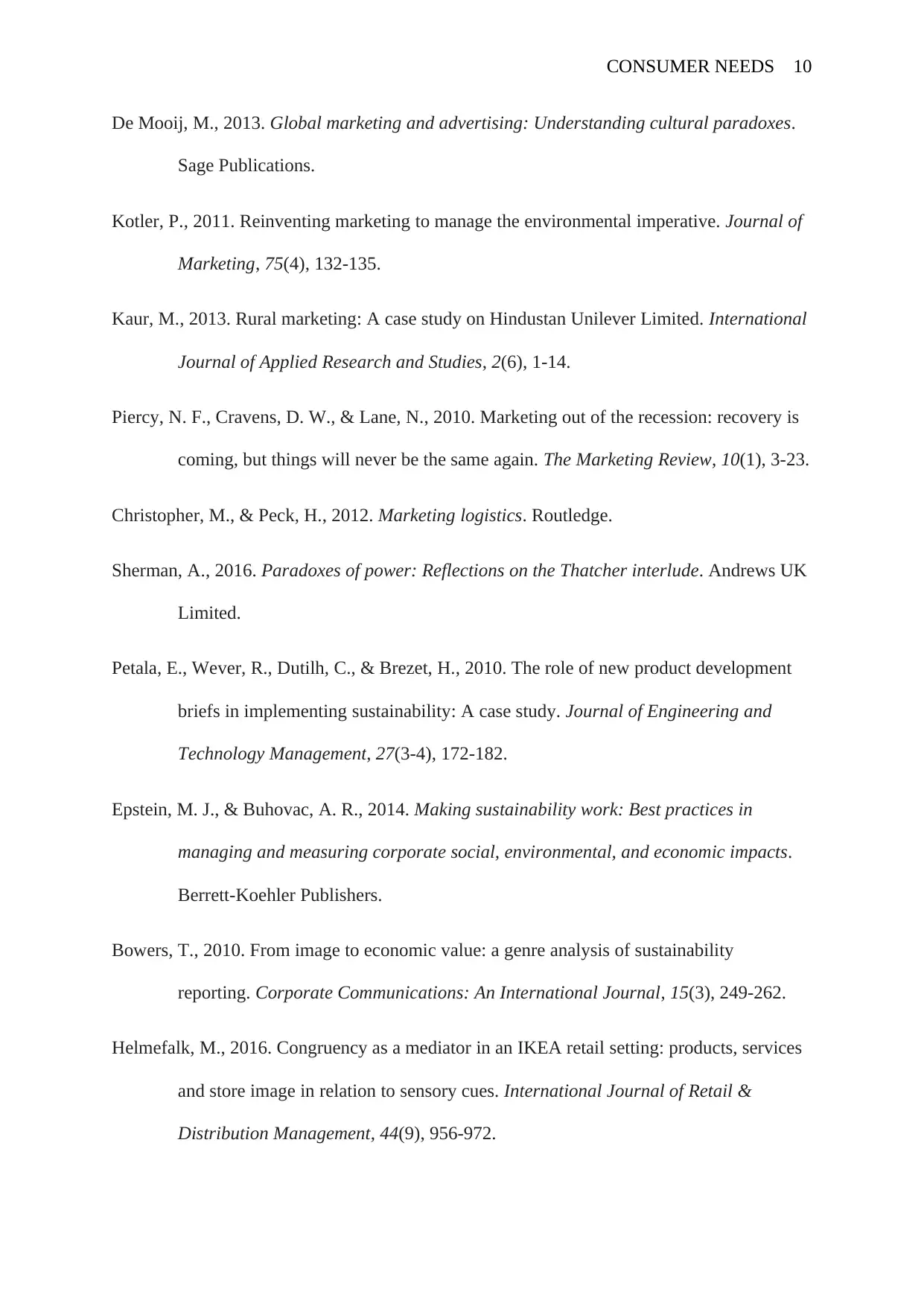
CONSUMER NEEDS 10
De Mooij, M., 2013. Global marketing and advertising: Understanding cultural paradoxes.
Sage Publications.
Kotler, P., 2011. Reinventing marketing to manage the environmental imperative. Journal of
Marketing, 75(4), 132-135.
Kaur, M., 2013. Rural marketing: A case study on Hindustan Unilever Limited. International
Journal of Applied Research and Studies, 2(6), 1-14.
Piercy, N. F., Cravens, D. W., & Lane, N., 2010. Marketing out of the recession: recovery is
coming, but things will never be the same again. The Marketing Review, 10(1), 3-23.
Christopher, M., & Peck, H., 2012. Marketing logistics. Routledge.
Sherman, A., 2016. Paradoxes of power: Reflections on the Thatcher interlude. Andrews UK
Limited.
Petala, E., Wever, R., Dutilh, C., & Brezet, H., 2010. The role of new product development
briefs in implementing sustainability: A case study. Journal of Engineering and
Technology Management, 27(3-4), 172-182.
Epstein, M. J., & Buhovac, A. R., 2014. Making sustainability work: Best practices in
managing and measuring corporate social, environmental, and economic impacts.
Berrett-Koehler Publishers.
Bowers, T., 2010. From image to economic value: a genre analysis of sustainability
reporting. Corporate Communications: An International Journal, 15(3), 249-262.
Helmefalk, M., 2016. Congruency as a mediator in an IKEA retail setting: products, services
and store image in relation to sensory cues. International Journal of Retail &
Distribution Management, 44(9), 956-972.
De Mooij, M., 2013. Global marketing and advertising: Understanding cultural paradoxes.
Sage Publications.
Kotler, P., 2011. Reinventing marketing to manage the environmental imperative. Journal of
Marketing, 75(4), 132-135.
Kaur, M., 2013. Rural marketing: A case study on Hindustan Unilever Limited. International
Journal of Applied Research and Studies, 2(6), 1-14.
Piercy, N. F., Cravens, D. W., & Lane, N., 2010. Marketing out of the recession: recovery is
coming, but things will never be the same again. The Marketing Review, 10(1), 3-23.
Christopher, M., & Peck, H., 2012. Marketing logistics. Routledge.
Sherman, A., 2016. Paradoxes of power: Reflections on the Thatcher interlude. Andrews UK
Limited.
Petala, E., Wever, R., Dutilh, C., & Brezet, H., 2010. The role of new product development
briefs in implementing sustainability: A case study. Journal of Engineering and
Technology Management, 27(3-4), 172-182.
Epstein, M. J., & Buhovac, A. R., 2014. Making sustainability work: Best practices in
managing and measuring corporate social, environmental, and economic impacts.
Berrett-Koehler Publishers.
Bowers, T., 2010. From image to economic value: a genre analysis of sustainability
reporting. Corporate Communications: An International Journal, 15(3), 249-262.
Helmefalk, M., 2016. Congruency as a mediator in an IKEA retail setting: products, services
and store image in relation to sensory cues. International Journal of Retail &
Distribution Management, 44(9), 956-972.
Paraphrase This Document
Need a fresh take? Get an instant paraphrase of this document with our AI Paraphraser
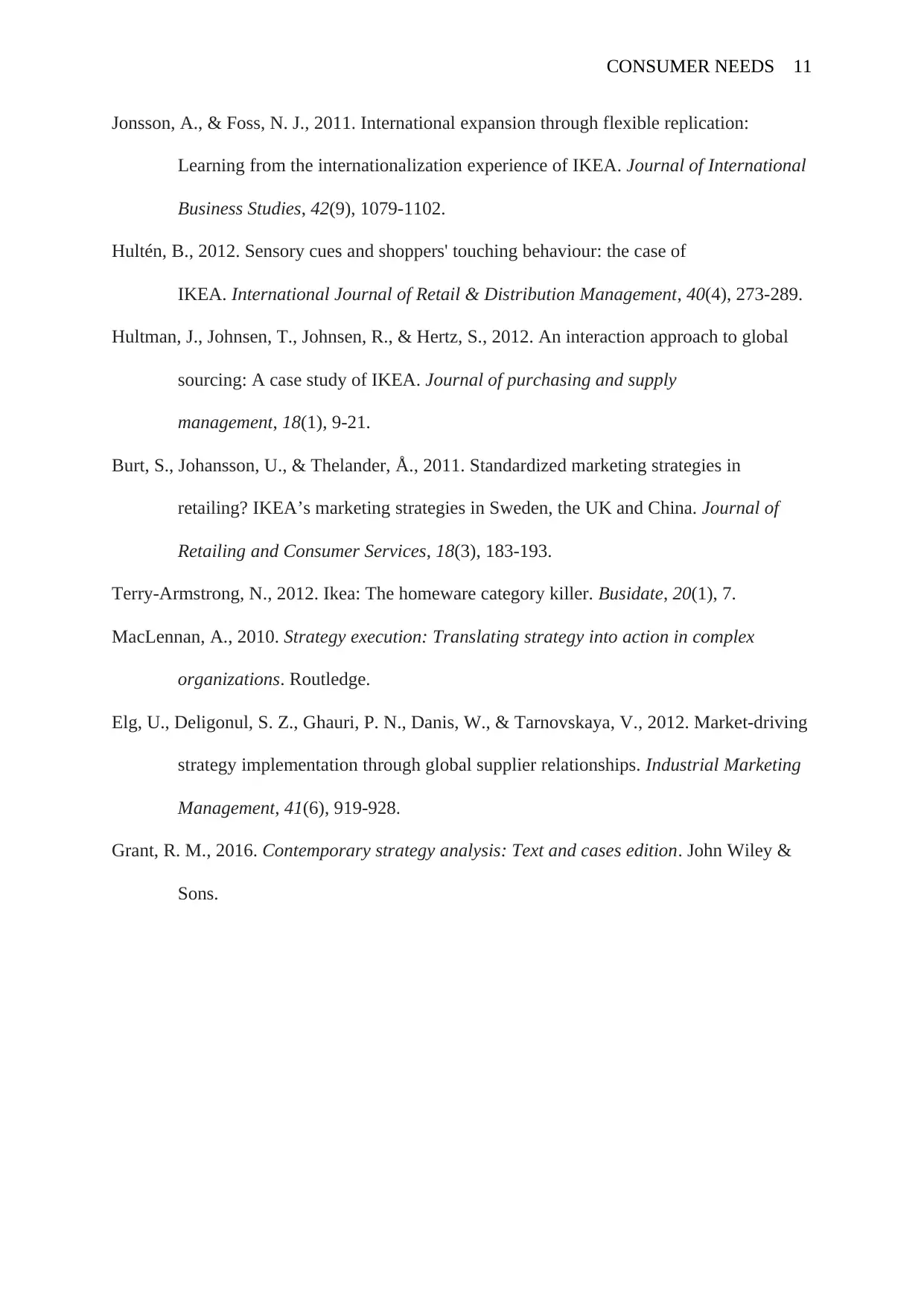
CONSUMER NEEDS 11
Jonsson, A., & Foss, N. J., 2011. International expansion through flexible replication:
Learning from the internationalization experience of IKEA. Journal of International
Business Studies, 42(9), 1079-1102.
Hultén, B., 2012. Sensory cues and shoppers' touching behaviour: the case of
IKEA. International Journal of Retail & Distribution Management, 40(4), 273-289.
Hultman, J., Johnsen, T., Johnsen, R., & Hertz, S., 2012. An interaction approach to global
sourcing: A case study of IKEA. Journal of purchasing and supply
management, 18(1), 9-21.
Burt, S., Johansson, U., & Thelander, Å., 2011. Standardized marketing strategies in
retailing? IKEA’s marketing strategies in Sweden, the UK and China. Journal of
Retailing and Consumer Services, 18(3), 183-193.
Terry-Armstrong, N., 2012. Ikea: The homeware category killer. Busidate, 20(1), 7.
MacLennan, A., 2010. Strategy execution: Translating strategy into action in complex
organizations. Routledge.
Elg, U., Deligonul, S. Z., Ghauri, P. N., Danis, W., & Tarnovskaya, V., 2012. Market-driving
strategy implementation through global supplier relationships. Industrial Marketing
Management, 41(6), 919-928.
Grant, R. M., 2016. Contemporary strategy analysis: Text and cases edition. John Wiley &
Sons.
Jonsson, A., & Foss, N. J., 2011. International expansion through flexible replication:
Learning from the internationalization experience of IKEA. Journal of International
Business Studies, 42(9), 1079-1102.
Hultén, B., 2012. Sensory cues and shoppers' touching behaviour: the case of
IKEA. International Journal of Retail & Distribution Management, 40(4), 273-289.
Hultman, J., Johnsen, T., Johnsen, R., & Hertz, S., 2012. An interaction approach to global
sourcing: A case study of IKEA. Journal of purchasing and supply
management, 18(1), 9-21.
Burt, S., Johansson, U., & Thelander, Å., 2011. Standardized marketing strategies in
retailing? IKEA’s marketing strategies in Sweden, the UK and China. Journal of
Retailing and Consumer Services, 18(3), 183-193.
Terry-Armstrong, N., 2012. Ikea: The homeware category killer. Busidate, 20(1), 7.
MacLennan, A., 2010. Strategy execution: Translating strategy into action in complex
organizations. Routledge.
Elg, U., Deligonul, S. Z., Ghauri, P. N., Danis, W., & Tarnovskaya, V., 2012. Market-driving
strategy implementation through global supplier relationships. Industrial Marketing
Management, 41(6), 919-928.
Grant, R. M., 2016. Contemporary strategy analysis: Text and cases edition. John Wiley &
Sons.
1 out of 11
Related Documents
Your All-in-One AI-Powered Toolkit for Academic Success.
+13062052269
info@desklib.com
Available 24*7 on WhatsApp / Email
![[object Object]](/_next/static/media/star-bottom.7253800d.svg)
Unlock your academic potential
Copyright © 2020–2025 A2Z Services. All Rights Reserved. Developed and managed by ZUCOL.





